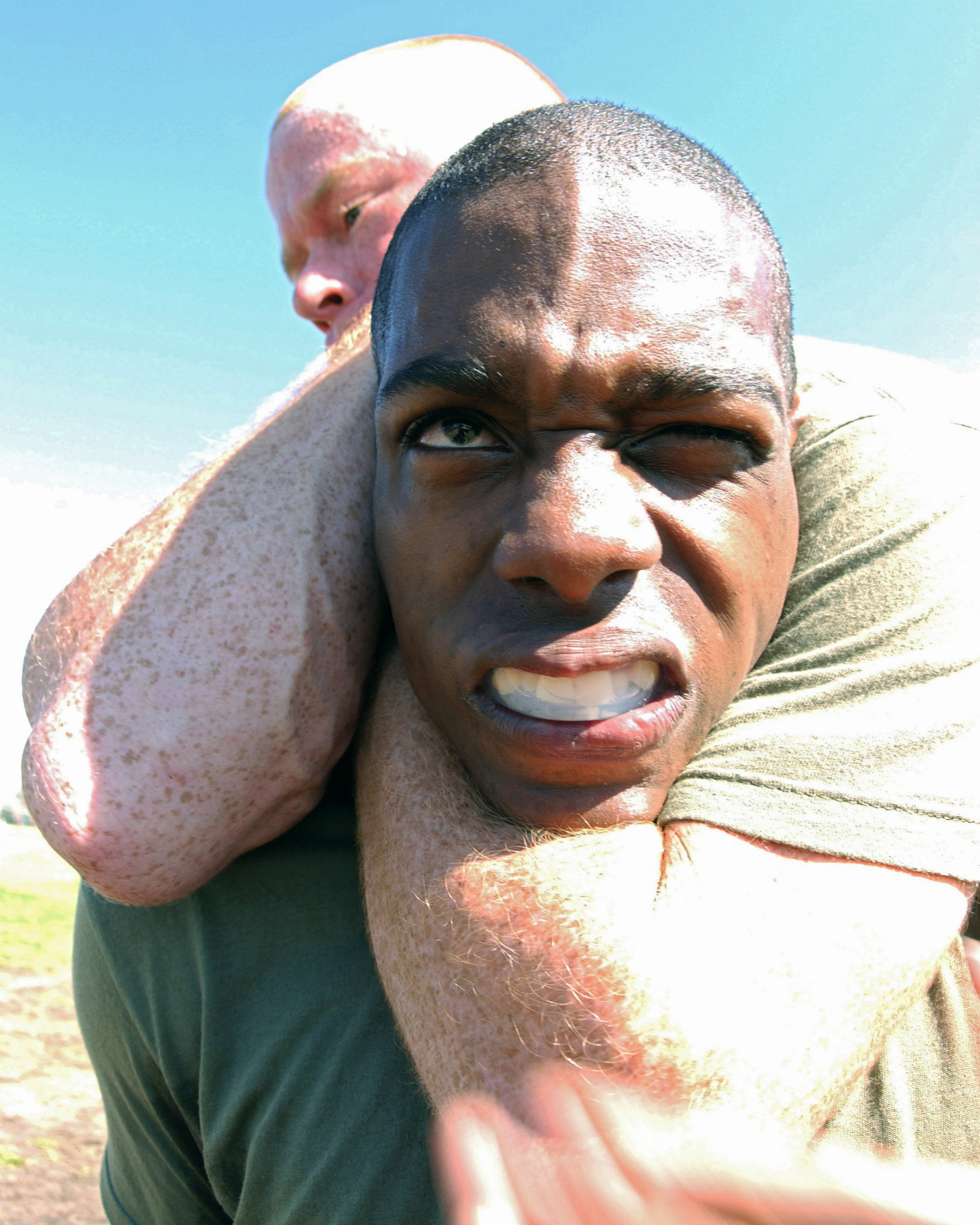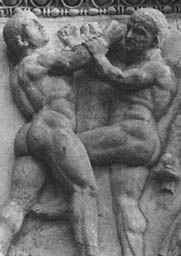|
Choke-out
A choke-out is a hand-to-hand combat tactic involving the use of a chokehold to cause Syncope (medicine), syncope, or temporary loss of consciousness, at which point the choke is released. Common chokeholds in grappling used to accomplish a choke-out include the rear naked choke, arm triangle, triangle choke, and the Guillotine choke, guillotine. The mechanism can be explained as resulting from directly constraining blood flow to the brain through constriction of the carotid arteries. An additional mechanism involves compression of the baroreceptors of the carotid arteries, confusing the body into thinking blood pressure has risen. Due to the baroreflex, this inhibits sympathetic vasomotor and cardiac stimulation and increases parasympathetic stimulation of the heart causing vasodilation and a lowered heart rate. This causes a dramatic decrease in blood flow especially to regions above the heart (e.g. the brain) due the need of a high pressure to flow against gravity which in turn ... [...More Info...] [...Related Items...] OR: [Wikipedia] [Google] [Baidu] |
Rear Naked Choke
The rear naked choke (RNC), also known as hadaka jime (裸絞) in Judo and "lion killer choke (Mata Leão)" in BJJ, is a chokehold in martial arts applied from an opponent's back. The word ''naked'' in this context suggests that, unlike other strangulation techniques found in jiujitsu/judo, this hold does not require the use of a keikogi ("gi") or training uniform. The choke has two variations: in one version, the attacker's arm encircles the opponent's neck and then grabs their biceps/shoulder on the other arm (see below for details); in the second version, the attacker clasps their hands together instead after encircling the opponent's neck. Recent studies have shown that the rear-naked choke takes an average of 8.9 seconds to render an opponent unconscious, regardless of the grip that is used. "Figure four" or "short" variation This variant is considered to be a "''Chokehold#Blood choke, blood choke''" because it restricts blood flow to the brain via the carotid artery, caroti ... [...More Info...] [...Related Items...] OR: [Wikipedia] [Google] [Baidu] |
Hand-to-hand Combat
Hand-to-hand combat is a physical confrontation between two or more persons at short range (grappling distance or within the physical reach of a handheld weapon) that does not involve the use of ranged weapons.Hunsicker, A., ''Advanced Skills in Executive Protection'', Boca Raton FL: Universal Publishers, , , p. 51 The phrase "hand-to-hand" sometimes includes use of melee weapons such as knives, swords, Club (weapon), clubs, spears, axes, or improvised weapons such as entrenching tools. While the term "hand-to-hand combat" originally referred principally to engagements by combatants on the battlefield, it can also refer to any personal physical engagement by two or more people, including law enforcement officers, civilians, and criminals. Combat within close quarters, to a range just beyond grappling distance, is commonly termed close combat or close-quarters combat. It may include lethal and non-lethal weapons and methods depending upon the restrictions imposed by civilian law, ... [...More Info...] [...Related Items...] OR: [Wikipedia] [Google] [Baidu] |
Spasm
A spasm is a sudden involuntary contraction of a muscle, a group of muscles, or a hollow organ, such as the bladder. A spasmodic muscle contraction may be caused by many medical conditions, including dystonia. Most commonly, it is a muscle cramp which is accompanied by a sudden burst of pain. A muscle cramp is usually harmless and ceases after a few minutes. It is typically caused by ion imbalance or muscle fatigue. There are other causes of involuntary muscle contractions, and some of these may cause a health problem. A series of spasms, or permanent spasms, is referred to as a "spasmism". Description and causes Spasms occur when the part of the brain that controls movement malfunctions, causing involuntary muscle activity. A spasm may be a muscle contraction caused by abnormal nerve stimulation or by abnormal activity of the muscle itself. Causes The cause of spasms is often unknown, but it can be due to an inherited genetic problem, a side effect of medicatio ... [...More Info...] [...Related Items...] OR: [Wikipedia] [Google] [Baidu] |
American Neurological Association
The American Neurological Association (ANA) is a professional society of academic neurologists and neuroscientists devoted to advancing the goals of academic neurology; to training and educating neurologists and other physicians in the neurologic sciences; and to expanding both our understanding of diseases of the nervous system and our ability to treat them. It was founded in June 1875. See also * American Medical Association * American Psychiatric Association The American Psychiatric Association (APA) is the main professional organization of psychiatrists and trainee psychiatrists in the United States, and the largest psychiatric organization in the world. It has more than 39,200 members who are in ... * Transactions of the American Neurological Association * Sarah McNutt References External links * Medical associations based in the United States Neurology organizations Organizations established in 1875 Medical and health organizations based in New Jers ... [...More Info...] [...Related Items...] OR: [Wikipedia] [Google] [Baidu] |
Judo
is an unarmed gendai budō, modern Japanese martial art, combat sport, Olympic sport (since 1964), and the most prominent form of jacket wrestling competed internationally.『日本大百科全書』電子版【柔道】(CD-ROM version of Encyclopedia Nipponica, "Judo"). Judo was created in 1882 by Kanō Jigorō () as an eclectic martial art, distinguishing itself from its predecessors (primarily Tenjin Shin'yō-ryū, Tenjin Shinyo-ryu jujutsu and Kitō-ryū jujutsu) due to an emphasis on "randori" (, lit. 'free sparring') instead of alongside its removal of striking and weapon training elements. Judo rose to prominence for its dominance over Kodokan–Totsuka rivalry, established jujutsu schools in tournaments hosted by the Tokyo Metropolitan Police Department (警視庁武術大会, ''Keishicho Bujutsu Taikai''), resulting in its adoption as the department's primary martial art. A judo practitioner is called a , and the judo uniform is called . The objective of competitive ju ... [...More Info...] [...Related Items...] OR: [Wikipedia] [Google] [Baidu] |
Asystole
Asystole (New Latin, from Greek privative a "not, without" + ''systolē'' "contraction") is the absence of ventricular contractions in the context of a lethal heart arrhythmia (in contrast to an induced asystole on a cooled patient on a heart-lung machine and general anesthesia during surgery necessitating stopping the heart). Asystole is the most serious form of cardiac arrest and is usually irreversible. Also referred to as cardiac flatline, asystole is the state of total cessation of electrical activity from the heart, which means no tissue contraction from the heart muscle and therefore no blood flow to the rest of the body. Asystole should not be confused with very brief pauses below 3 seconds in the heart's electrical activity that can occur in certain less severe abnormal rhythms. Asystole is different from very fine occurrences of ventricular fibrillation, though both have a poor prognosis, and untreated fine VF will lead to asystole. Faulty wiring, disconnection of electr ... [...More Info...] [...Related Items...] OR: [Wikipedia] [Google] [Baidu] |
Flatline
A flatline is an electrical time sequence measurement that shows no activity and therefore, when represented, shows a flat line instead of a moving one. It almost always refers to either a flatlined electrocardiogram, where the heart shows no electrical activity ( asystole), or to a flat electroencephalogram, in which the brain shows no electrical activity (brain death). Both of these specific cases are involved in various definitions of death. ECG/EKG (Electrocardiogram/Cardiac) flatline A cardiac flatline is also called asystole. It can possibly be generated by malfunction of the electrocardiography device, but it is recommended to first rule out true asystole because of the emergence of such condition. Definition: A cardiac flatline is referred to as asystole. It can be identified by using an ECG/EKG (electrocardiogram) test. Asystole occurs when the electrical and mechanical activities of the heart stop. Causes: ECG/EKG flatline or asystole occurs when the heart's el ... [...More Info...] [...Related Items...] OR: [Wikipedia] [Google] [Baidu] |
Vagus Nerve
The vagus nerve, also known as the tenth cranial nerve (CN X), plays a crucial role in the autonomic nervous system, which is responsible for regulating involuntary functions within the human body. This nerve carries both sensory and motor fibers and serves as a major pathway that connects the brain to various organs, including the heart, lungs, and digestive tract. As a key part of the parasympathetic nervous system, the vagus nerve helps regulate essential involuntary functions like heart rate, breathing, and digestion. By controlling these processes, the vagus nerve contributes to the body's "rest and digest" response, helping to calm the body after stress, lower heart rate, improve digestion, and maintain homeostasis. The vagus nerve consists of two branches: the right and left vagus nerves. In the neck, the right vagus nerve contains approximately 105,000 fibers, while the left vagus nerve has about 87,000 fibers, according to one source. However, other sources report sl ... [...More Info...] [...Related Items...] OR: [Wikipedia] [Google] [Baidu] |
Heart
The heart is a muscular Organ (biology), organ found in humans and other animals. This organ pumps blood through the blood vessels. The heart and blood vessels together make the circulatory system. The pumped blood carries oxygen and nutrients to the tissue, while carrying metabolic waste such as carbon dioxide to the lungs. In humans, the heart is approximately the size of a closed fist and is located between the lungs, in the middle compartment of the thorax, chest, called the mediastinum. In humans, the heart is divided into four chambers: upper left and right Atrium (heart), atria and lower left and right Ventricle (heart), ventricles. Commonly, the right atrium and ventricle are referred together as the right heart and their left counterparts as the left heart. In a healthy heart, blood flows one way through the heart due to heart valves, which prevent cardiac regurgitation, backflow. The heart is enclosed in a protective sac, the pericardium, which also contains a sma ... [...More Info...] [...Related Items...] OR: [Wikipedia] [Google] [Baidu] |
Glossopharyngeal Nerve
The glossopharyngeal nerve (), also known as the ninth cranial nerve, cranial nerve IX, or simply CN IX, is a cranial nerve that exits the brainstem from the sides of the upper Medulla oblongata, medulla, just anterior (closer to the nose) to the vagus nerve. Being a mixed nerve (sensorimotor), it carries afferent sensory and efferent motor information. The motor division of the glossopharyngeal nerve is derived from the Basal plate (neural tube), basal plate of the embryonic medulla oblongata, whereas the sensory division originates from the cranial neural crest. Structure From the anterior portion of the medulla oblongata, the glossopharyngeal nerve passes laterally across or below the Flocculus (cerebellar), flocculus, and leaves the skull through the central part of the jugular foramen. From the superior and inferior ganglia in jugular foramen, it has its own sheath of dura mater. The inferior ganglion on the inferior surface of petrous part of temporal is related with a tri ... [...More Info...] [...Related Items...] OR: [Wikipedia] [Google] [Baidu] |
SB Nation
''SB Nation'' (an abbreviation for their full name ''SportsBlogs Nation'') is a sports blogging network owned by Vox Media. It was co-founded by Tyler Blezinski, Markos Moulitsas, and Jerome Armstrong in 2003. The blog from which the network formed was started by Bleszinski as ''Athletics Nation'' in 2003, and focused solely on the Oakland Athletics. It later expanded to cover sports franchises on a national scale, including all Major League Baseball, National Basketball Association, and National Football League teams, as well as college teams, mixed martial arts and professional wrestling, and more, totaling over 300 community sites at its peak. The coverage style of SB Nation’s communities have an emphasis on covering sports from the perspective of fans. In 2011, the network expanded into technology content with '' The Verge'', leading to the parent company Sports Blogs Inc. being rebranded as Vox Media. ''SB Nation'' operates from Vox Media's offices in New York City ... [...More Info...] [...Related Items...] OR: [Wikipedia] [Google] [Baidu] |





